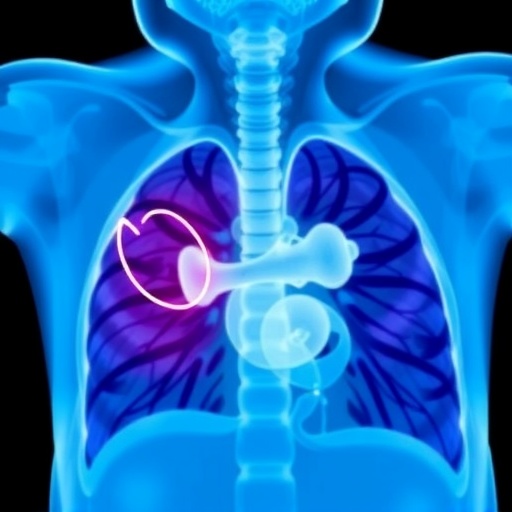In a groundbreaking study, researchers have introduced a novel framework for surgical process modeling, focusing on workflow and performance in image-guided bronchoscopy. This critical advancement aims to enhance the precision and efficacy of bronchoscopic procedures, which are vital for diagnosing and treating various pulmonary conditions. The significance of this work lies in its potential to transform current practices in interventional pulmonology, leading to improved patient outcomes and operational efficiency.
The exploration into surgical process modeling comes at a crucial time when healthcare systems are increasingly relying on advanced technologies to bolster surgical precision. Image-guided bronchoscopy stands out as an exemplary technique, combining real-time imaging with minimally invasive procedures. However, the complexity of these procedures necessitates a structured approach to understand and analyze the intricate workflows involved. The research undertaken by Rypinski, Casal, and Pillai sheds light on these complexities by proposing a comprehensive model that streamlines the surgical workflow.
By employing sophisticated modeling techniques, the researchers have been able to delineate individual steps within the bronchoscopic procedure, allowing for a detailed analysis of each phase. This approach enables the identification of bottlenecks and inefficiencies that could impede successful outcomes. Through thorough observation and data collection, the team has amassed significant insights into the workflow, which can now be leveraged to optimize the surgical process.
At the heart of this study is the utilization of advanced imaging technologies that facilitate real-time tracking of the tools and instruments used in image-guided bronchoscopy. The integration of these technologies not only enhances visibility but also allows for precise navigation through the complex anatomy of the lungs. This capability is especially crucial when targeting specific lesions or abnormalities that may be challenging to reach without accurate guidance.
Moreover, the study emphasizes the importance of data analytics in surgical process modeling. By analyzing various performance metrics, researchers can establish benchmarks that inform best practices in bronchoscopic procedures. These metrics may include procedure time, accuracy of lesion targeting, and rates of complications. The implementation of such analytics into the surgical workflow can lead to continuous improvement, fostering a culture of excellence in patient care.
One of the most significant contributions of this research is its potential impact on training and education in the field of pulmonary medicine. By creating a well-defined framework for surgical processes, it paves the way for enhanced training modules that can benefit both novice and experienced practitioners. Future training programs equipped with these insights can ensure that surgeons not only grasp the technical skills required but also understand the broader context of workflow efficiency and patient safety.
As the healthcare landscape evolves, the role of simulation in surgical training becomes increasingly relevant. The modeling framework proposed in this work can serve as a basis for developing simulation scenarios that replicate real-world bronchoscopic procedures. This would allow trainees to practice their skills in a controlled environment, honing their abilities and ultimately improving surgical outcomes when they transition to actual patient care situations.
Furthermore, the researchers have highlighted the collaborative nature of modern surgical practices. With the introduction of multi-disciplinary teams involved in image-guided bronchoscopy, ensuring effective communication and coordination is paramount. The structured workflow model can facilitate better teamwork by providing clear guidelines and responsibilities at each stage of the procedure. This alignment not only enhances operational efficiency but also fosters a supportive environment for healthcare professionals.
Another compelling element of this research is its acknowledgment of patient-centered care. By focusing on workflow optimization, the model also takes into account the patient experience during bronchoscopic procedures. Streamlined processes not only reduce the time patients spend undergoing these interventions but can also mitigate anxiety and discomfort associated with surgical procedures. Ultimately, a careful balance between efficiency and compassion in patient care is essential in building trust and ensuring satisfaction.
The insights derived from this study have broader implications that extend beyond bronchoscopic procedures. The methodologies and frameworks developed can be adapted to inform surgical process modeling in various medical fields. As different specialties grapple with distinct operational challenges, the principles of workflow analysis and performance assessment can serve as a universal foundation for improving surgical care.
In conclusion, the work of Rypinski, Casal, and Pillai marks a significant stride in the evolution of surgical process modeling in image-guided bronchoscopy. Their research not only provides a robust framework for enhancing workflow and performance but also embodies the growing intersection of technology and healthcare. With continual advancements in imaging and data analytics, the future of bronchoscopic procedures looks promising, poised to deliver even greater precision and improved outcomes for patients around the globe.
The study underscores the pivotal role that such research plays in advancing medical practices and ensuring that healthcare professionals are equipped with the necessary tools to succeed in an ever-changing landscape. As the medical community embraces these innovations, the ultimate goal remains: to enhance patient care and sustain a culture of excellence in surgical interventions.
Subject of Research: Surgical Process Modeling in Image-Guided Bronchoscopy
Article Title: Surgical Process Modeling of Workflow and Performance in Image-Guided Bronchoscopy
Article References: Rypinski, T.A., Casal, R.F., Pillai, P.S. et al. Surgical Process Modeling of Workflow and Performance in Image-Guided Bronchoscopy. Ann Biomed Eng (2025). https://doi.org/10.1007/s10439-025-03861-5
Image Credits: AI Generated
DOI: 10.1007/s10439-025-03861-5
Keywords: surgical process modeling, workflow optimization, image-guided bronchoscopy, pulmonary medicine, data analytics, patient-centered care, surgical training, technology in healthcare.




